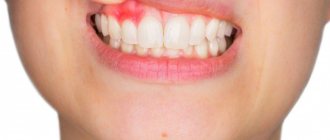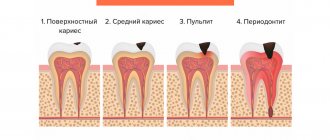Dental periodontitis: what it is, how to treat it
| Treatment of periodontitis always begins with a doctor analyzing the patient’s complaints and studying the image. Only after this will it be possible to understand whether a tooth will need to be removed due to periodontitis, or whether it can be saved! |
Treatment of periodontitis: stages
- If the disease has reached an acute stage, then the doctor’s first priority is to create an opportunity for the pus to flow out, since otherwise it will not be possible to get rid of the acute pain.
- The crown (if any) is removed, the root canals are unfilled (this must be done on the patient’s first visit).
- If the gums are swollen, the abscess will need to be opened.
Open root canals will allow the pus to drain freely, which will significantly relieve the pain. In addition to this, the dentist will prescribe antibiotics and rinses. A repeat visit is scheduled no earlier than two to three days later. If the pus no longer drains by this point, an antiseptic drug is placed in the canals.
Further methods of treating periodontitis will largely be determined by the size of the inflammatory focus.
Treatment of acute periodontitis of the tooth
The acute stage of the disease is accompanied by severe pain, forcing the patient to consult a doctor as soon as possible.
During the visit, the doctor removes the pulp (the root canals are not closed, since a path is needed for the pus to exit). A crown or filling may need to be removed. If the gums are swollen, the dentist may decide to make an incision to facilitate the release of purulent masses.
In most cases, these measures are enough to make the pain go away. In addition to surgical measures, the patient is prescribed drug therapy in the form of taking oral antibiotics and rinsing with them.
After 4 days, a follow-up visit is scheduled, during which the doctor checks whether all the pus has come out. To achieve final cleaning, an antiseptic is placed into the tooth.
Then, with the help of medications, the inflammatory process is relieved, and the canals are sealed. In some cases, bone tissue restoration and long-term anti-inflammatory therapy may be required. Sometimes a doctor may find it advisable to get rid of a cyst using a laser.
Treatment of chronic periodontitis
Treatment of the fibrotic form involves several visits to the doctor over the course of a week. Since the upper part of the root is not changed, the technique allows you to fill the canals at the next visit to a specialist.
But the treatment process for granulating and granulomatous periodontitis can take a couple of months, especially if there is a complication.
The following procedures are carried out first:
- a picture is taken;
- under anesthesia, carious areas are drilled and access to the canals is provided;
- if the tooth has not been treated, the pulp is removed, if it has been filled, then the canals are unsealed;
- the channels are expanded and treated with an antiseptic solution;
- until the patient’s next visit to the doctor, an antiseptic is placed in the canals (usually Cresophenon is used);
- a temporary filling is placed;
- Anti-inflammatory drugs may be prescribed (but this is not always done).
The next visit is scheduled in three days:
- the previously placed temporary filling and the medicine placed in the canals are removed;
- the channels are thoroughly washed with antiseptics;
- The canals are filled and then a temporary filling is placed again.
On last visit:
- a picture is taken that makes it possible to understand how successful the tooth restoration after periodontitis was;
- The filling material is removed from the canals and treated with an antiseptic;
- the channels are sealed;
- Another picture is taken to determine whether the canals have been sealed to their entire length, otherwise the disease may begin again after some time.
If the size of the cyst exceeds 1.5 cm (cases have been recorded when the formation can grow up to 5 cm), then after filling, root resection and subsequent restoration of the tooth are performed.
Diagnostics
Diagnosis of periodontitis is carried out on the basis of a clinical examination, including:
- interviewing the patient,
- visual examination of the oral cavity,
- probing the entrance to the tooth cavity,
- determination of the degree of tooth mobility.
To accurately establish a diagnosis in dentistry, the following is used:
- X-ray examination;
- radiovisiography;
- transillumination;
- electroodontodiagnostics.
In case of acute inflammation, an X-ray image will not yet show any changes in the periodontium, but in the chronic course of the disease, an X-ray is simply necessary. With its help you can determine the form of chronic periodontitis:
– with fibrous periodontitis, the image will show uneven changes in the lumen of the periodontal fissure; sometimes there is thickening of the root in the apical region. In some cases, sclerosis of the alveolar bone tissue is observed around the source of inflammation.
– with granulating periodontitis, more or less extensive granulations (growths) appear in the periodontium, usually round in shape with unclear boundaries. The image also shows a pronounced deformation of the periodontal fissure and reduced bone density.
– with granulomatous periodontitis, it is clear that the growing granuloma (round in shape with clear boundaries) gradually destroys the bone tissue of the alveoli, developing into a cystogranuloma, and then into a cyst, which begins to grow from the apex of the tooth towards the bone tissue. Such a pathological process usually requires surgical intervention.
Exacerbation of periodontitis: how does it manifest?
The chronic form of the disease may not have any symptoms for a long time, but sometimes exacerbation phases may occur.
At such moments, the disease begins to resemble the acute stage of development: the gums swell, severe pain occurs, and pus appears. When there is no more pus left in the lesion, the pain goes away and the symptoms disappear, but this does not mean that periodontitis has been cured: it has simply entered the chronic stage again. After some time, an exacerbation will occur again, accompanied by the same symptoms.
Factors such as hypothermia, various diseases, or simply a weakened immune system can provoke an exacerbation of the disease.
Prevention means
There are several simple remedies to prevent this disease:
- Always maintain good oral hygiene . Many problems arise precisely because the patient brushes his teeth incorrectly or irregularly or does not use dental floss. Changes in the condition of the mucous membrane, the composition of saliva under the influence of gastrointestinal diseases and hormonal imbalance can also have a negative impact.
- Come regularly for preventive examinations and dental treatment . You can’t start caries and gum disease. They can progress and develop even when the patient himself practically does not understand this. Therefore, prevention and examinations by dentists yield clear results.
- Always get treatment from trusted doctors . Periodontitis can be caused by improperly treated caries or poorly cleaned dental canals. In this case, inflammation may also affect neighboring teeth, and there is a possibility that extraction will be necessary.
Remember also that regardless of the current situation, you should not endure pain. Even if it appears rarely and quickly recedes, you should definitely make an appointment for a preventive appointment and check if everything is okay with your body.
Complications after periodontitis treatment
Within a week after treatment, pain may be observed when clenching the jaws, but this phenomenon is considered normal and is not a complication. To minimize the risk of such an effect, you should try not to use the treated tooth - do not touch it or chew with it, do not eat too cold or hot food.
One of the most common complications is the poor quality of filled canals. This does not necessarily happen because the dentist is inexperienced: the fact is that the canals can be very long and curved, so placing a full filling material in them can be problematic.
The consequence of this is severe pain, swelling and the development of an inflammatory process, which can lead to the recurrence of periodontitis.
To avoid this complication, after filling, the dentist should send the patient for an x-ray to monitor the result, and also schedule a follow-up visit a couple of weeks after treatment to monitor the situation.
If root resection was performed during treatment, the recovery process may take a slightly longer period of time: pain in the gums may be observed for several weeks, which can be reduced by rinsing with antiseptics.
Symptoms of the disease
In the early stages, many people confuse acute periodontitis with ordinary toothache. There are several most common signs:
- The concentration of pain is clearly around the inflamed area. At the same time, they intensify when the tooth is at rest; they can weaken if you put pressure on it or start chewing something.
- Severe inflammation on the gum next to the tooth. It can occur according to different principles, but swelling, increased tissue temperature, and redness are always noticeable.
- The beginning of the separation of pus. At an early stage, when pressed, you will see only a colorless liquid, and at a later stage, normal suppuration will begin.
Risk factors include tooth filling. If you feel that the tooth under the filling hurts, the reason is not necessarily the poor work of the dentist.
Tissue inflammation can be provoked by other reasons - infections, taking medications of certain categories.
It is worth remembering that even teeth with the roots removed are susceptible to such inflammation.
The longer treatment is delayed, the more severe the problems will be. In the later stages, the lesion already covers several teeth, and it seems that the entire jaw hurts. The nature of the pain changes - it becomes more acute, pulsating, as with caries.
In very advanced cases, it may be painful for the patient not only to chew, but even to turn his head - the pain begins to noticeably resonate in the neck.
Price
The cost of periodontitis treatment is always strictly individual and consists of a combination of factors. These include diagnostics at the initial and intermediate stages of treatment, the diagnosis made and the algorithm of treatment measures adopted on its basis, the number of visits, drugs, equipment and technologies used in treatment, the work of specialized specialists if necessary, the level of qualifications of the doctor.
Periodontitis is a very serious disease of the teeth and the dental system as a whole. Failure to consult a doctor in a timely manner and attempts at self-medication can lead to serious complications, including those that can threaten your life. At the first appearance of symptoms, you must urgently visit the dental clinic! Be prepared for long-term treatment, which involves multiple visits to the doctor, since the treatment of periodontitis consists of several stages, each of which cannot be started without diagnostically proven effectiveness of the previous one. Only this approach to treatment, combined with the professionalism of the doctor and the patient’s strict, vigilant attitude to all prescriptions and recommendations, is a guarantee of high-quality treatment and reliable protection against relapse for several years.
According to antiplagiat.ru, the uniqueness of the text as of October 16, 2018 is 99%.
Key words, tags: caries, pulpitis, bone tissue destruction, cyst, odontogenic cyst, flux, OPTG image, tooth-preserving operations, resection of the apex of the tooth root, cystectomy, root amputation, dental microscope, preservation, tooth extraction .
1 I. Zimin “From the history of dentistry.” 2 “Teeth and dentistry. Essays on history” / K.A. Pashkov. – M.: Veche, 2014. – 240 p.: ill. 3 Britova, A. A. Endodontics. Diseases of the dental pulp and periapical tissues: textbook. manual, 3rd ed., rev. and additional / A. A. Britova; NovSU named after. Yaroslav the Wise. – Veliky Novgorod, 2021. – 171 p. 4 https://elestom.ru/recommends INTERNATIONAL CLASSIFICATION OF DENTAL DISEASES ICD-C-3 BASED ON ICD-10. 5 https://elestom.ru/recommends INTERNATIONAL CLASSIFICATION OF DENTAL DISEASES ICD-C-3 BASED ON ICD-10. 6 https://mkb-10.com 7 Kleshchenko A. V. Improving the technique of unfilling root canals of teeth obturated with gutta-percha: Dissertation of a candidate of medical sciences: 01/14/14 / Kleshchenko Alexander Viktorovich; (Place of defense: Moscow State Medical and Dental University). - Moscow, 2011 - 93 p. 8 Report of the American Society of Microbiology based on the work. Author: Tobjörn Bengtson, presented by the Faculty of Clinical Medicine, School of Health Sciences, Örebro University, Sweden. * NOS is an abbreviation for “not otherwise specified,” meaning “unspecified” or “unspecified.”
Temporary and permanent root canal filling
After the operation to remove pus for acute periodontitis, 3-4 days should pass, and then the patient visits the clinic again. During the second appointment, the doctor performs the following manipulations:
1. Thoroughly rinses the canal cavities with antibacterial solutions, and then puts an antiseptic in them.
2. Places a temporary filling on the tooth.
The patient is sent home, but is warned: at the slightest sign of pain, he should immediately seek professional dental care.
Permanent filling of the canals is carried out during the third visit. The treatment procedure can be carried out in the absence of complaints from the patient about any discomfort, as well as in the complete absence of pus in the canal cavities. The canals are filled with gutta-percha composite to the upper root zone. Restoration of the aesthetics and functionality of the tooth is done on a subsequent visit, and at this point the course of periodontitis treatment is considered complete.
Age restrictions
Periodontitis can occur in a person of any age, and there are no age restrictions for its treatment. Pregnant women are treated with special care, since, on the one hand, periodontitis is a dangerous source of infection that reduces immunity and can threaten the adequate course of pregnancy, and on the other hand, highly effective drugs with a strong effect can also threaten the development of the fetus. Therefore, treatment of periodontitis during pregnancy and lactation is carried out using the most gentle methods and drugs. But in order to prevent such situations, it is necessary to carry out routine monitoring, sanitation and medical examination at any age, and even more so during periods of pregnancy planning, as well as the prenatal period.









